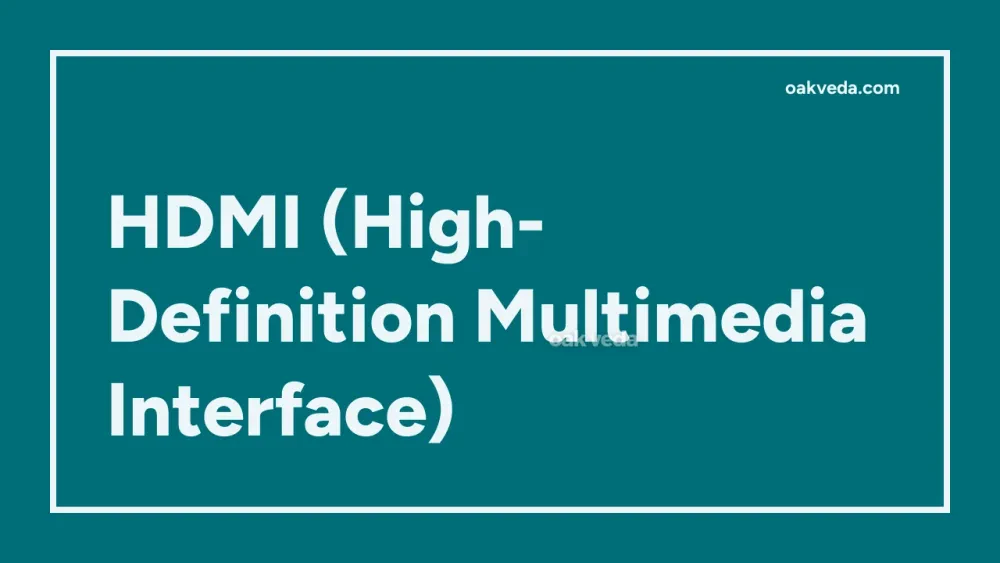
What is the Full Form of HDMI?
HDMI is the acronym for High-Definition Multimedia Interface. This digital interface has revolutionized how we transmit audio and video signals in modern electronic devices.
What is High-Definition Multimedia Interface?
High-Definition Multimedia Interface, commonly known as HDMI, is an all-digital audio-video interface that transmits uncompressed data between compatible devices. It serves as a single-cable solution for transferring high-quality digital audio and video signals from source devices to display units.
Origin and Development of High-Definition Multimedia Interface
The development of HDMI began in the early 2000s as a response to the growing need for a digital alternative to analog audio-video connections. A consortium of major electronics manufacturers, including Sony, Hitachi, Philips, and Toshiba, collaborated to create this new standard.
HDMI 1.0 was first introduced in December 2002, with production of HDMI-enabled devices beginning in late 2003. Since then, the technology has undergone several iterations, each bringing improvements in bandwidth, resolution support, and additional features.
How does High-Definition Multimedia Interface work?
HDMI works by transmitting digital audio and video signals through a single cable. The interface uses Transition Minimized Differential Signaling (TMDS) to encode and send the data. This method allows for high-speed, low-noise transmission of large amounts of data over relatively short distances.
When an HDMI cable connects a source device (like a Blu-ray player) to a display device (like a TV), it establishes a secure, encrypted connection. This connection, known as HDCP (High-bandwidth Digital Content Protection), ensures that copyrighted content is protected during transmission.
Types of High-Definition Multimedia Interface Cables
There are several types of HDMI cables, each designed for specific performance requirements:
-
Standard HDMI Cable: Also known as Category 1, this cable supports up to 1080i resolution and is suitable for most home entertainment setups.
-
High-Speed HDMI Cable: Also called Category 2, this cable supports higher resolutions up to 4K and is ideal for more demanding applications.
-
Premium High-Speed HDMI Cable: This cable is certified to support 4K resolution at 60Hz and HDR (High Dynamic Range) content.
-
Ultra High-Speed HDMI Cable: The latest standard, supporting 8K resolution and dynamic HDR formats.
Functions of High-Definition Multimedia Interface
HDMI serves several crucial functions in modern digital technology:
- Transmitting high-quality digital audio and video signals
- Supporting various video resolutions, including 4K and 8K
- Enabling advanced color spaces for more vibrant and accurate images
- Facilitating two-way communication between connected devices (CEC - Consumer Electronics Control)
- Supporting multiple audio formats, from stereo to multi-channel surround sound
Applications of High-Definition Multimedia Interface
HDMI has found widespread use in various applications:
- Home entertainment systems (TVs, gaming consoles, Blu-ray players)
- Computer monitors and graphics cards
- Professional audio-video equipment
- Digital cameras and camcorders
- Mobile devices (smartphones and tablets)
- Automotive infotainment systems
Features of High-Definition Multimedia Interface
HDMI boasts several key features that have contributed to its widespread adoption:
- Single-cable solution: Eliminates the need for separate audio and video cables
- High bandwidth: Supports high-resolution video and multi-channel audio
- HDCP support: Ensures secure transmission of copyrighted content
- CEC functionality: Allows for control of multiple devices with a single remote
- Audio Return Channel (ARC): Enables two-way audio transmission
- Ethernet channel: Supports networking capabilities in compatible devices
Benefits of High-Definition Multimedia Interface
HDMI offers numerous advantages over older analog interfaces:
- Superior image and sound quality: Uncompressed digital transmission ensures the highest fidelity
- Simplified connectivity: A single cable replaces multiple analog connections
- Automatic device configuration: HDMI can automatically set optimal display settings
- Reduced cable clutter: Fewer cables mean a cleaner, more organized setup
- Future-proof technology: Backward compatibility ensures longevity
Limitations or Challenges of High-Definition Multimedia Interface
Despite its many advantages, HDMI does have some limitations:
- Cable length restrictions: Signal degradation can occur over long distances
- Potential for HDCP-related issues: Content protection can sometimes cause compatibility problems
- Cost: HDMI cables, especially high-speed versions, can be more expensive than analog alternatives
- Complexity: Advanced features like ARC and CEC can be challenging to set up and troubleshoot
Future Developments in High-Definition Multimedia Interface Technology
The HDMI standard continues to evolve, with future developments focusing on:
- Higher resolutions and refresh rates: Support for 8K and beyond at higher frame rates
- Enhanced Audio Return Channel (eARC): Improved audio bandwidth and lip-sync correction
- Dynamic HDR: Support for frame-by-frame HDR metadata
- Variable Refresh Rate (VRR): Smoother gaming experiences with reduced screen tearing
FAQs on HDMI Full Form
-
What is the maximum resolution supported by HDMI? The latest HDMI 2.1 standard supports resolutions up to 10K at 120Hz.
-
Can HDMI transmit both audio and video? Yes, HDMI can transmit both high-quality digital audio and video signals through a single cable.
-
Is HDMI backward compatible? Yes, newer HDMI versions are generally backward compatible with older versions, although some advanced features may not be available.
-
What is the difference between HDMI and DisplayPort? While both transmit digital audio and video, HDMI is more common in consumer electronics, while DisplayPort is often used in professional and computer applications.
-
Can HDMI support 3D content? Yes, HDMI 1.4 and later versions support various 3D formats.
You may be interested in:

